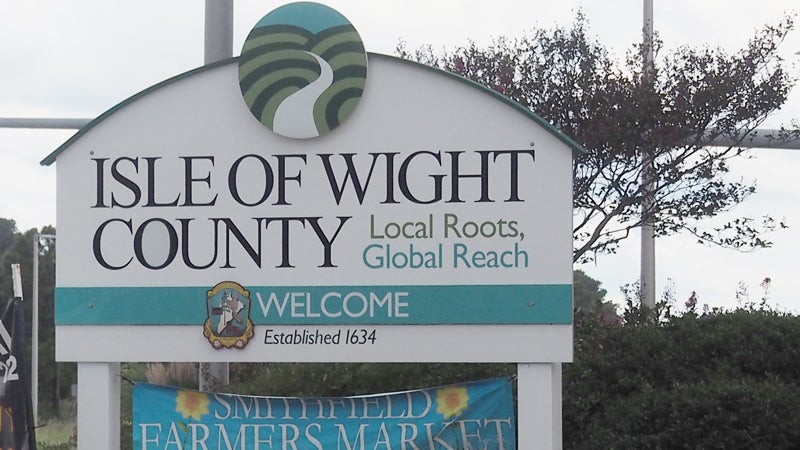Isle of Wight has fifth highest per capita debt among Virginia counties
Published 2:44 pm Wednesday, February 17, 2016
By Diana McFarland
News editorIsle of Wight County has the fifth highest per capita net debt among Virginia’s counties, according to the draft Comparative Report of Local Government Revenues and Expenditures for fiscal 2015.
Isle of Wight currently carries a debt of $218.5 million in principal and interest, and which represents $5,993 for every man, woman and child in the county, according to the report compiled by the Virginia Auditor of Public Accounts.
Surpassing Isle of Wight in per capita debt is Goochland County at $7,660, Arlington County at $6,311, Spotsylvania County at $6,150 and Loudoun County with $6,095.
The county’s heavy debt load and being close to violating its reserve policy, are challenges facing Isle of Wight as it goes into the fiscal 2017 budget season.
County staff has been instructed not to draw from reserves, to present a level budget except for the salary increases from last year’s study. Any new initiatives requested by staff will need to be justified, said Isle of Wight County spokesman Don Robertson at a recent Board of Supervisors work session.
The salary increases were estimated to cost $817,230, and former County Administrator Anne Seward said staff had found $350,000 in savings to partially defray the cost.
Meanwhile, the county’s debt has grown 111 percent in the past 10 years, from $67 million in 2006 to $141 million in 2015, according to the Davenport & Company report presented earlier this month. Davenport advises the Board of Supervisors on financial matters.
(Those numbers differ from what is reported in the Comparative Government report, which states Isle of Wight has $149 million in principal debt and $218.5 million when combined with interest. Those numbers were the county’s position at the end of June 2015).
The largest category of debt is carried by the general fund (41 percent), followed by schools (33 percent) and utilities (25 percent).
“The biggest red flag is the amount of debt we’re carrying,” said Board Chairman Rex Alphin about how debt affects the county’s rating with the rating agencies, Standard and Poor’s, Moody’s and Fitch.
All three rating agencies commented on the county’s debt level in their rating reports.
“In our opinion, the county’s debt and contingent liabilities profile is very weak with debt service of 11.8 percent of operating expenditures and net direct debt of more than two times the county operating revenue,” according to Standard & Poor’s.
Currently, Isle of Wight is carrying an Aa2 rating, which is in the top third of rated counties in Virginia, said David Rose, senior vice president with Davenport.
Of the county’s expenditures, 9 percent is spent on debt service and that is expected to jump from $8.5 million for the upcoming fiscal year to $11 million in fiscal 2019.
The county’s policy is that debt service should not exceed 12 percent, Rose said.
Since 2002, Isle of Wight has spent $103 million on multiple capital projects including the Smithfield Volunteer Fire Station ($5 million), Smithfield Middle School and other school improvements ($26 million), the Young Laine Courts building ($17 million), Georgie D. Tyler Middle School ($24 million), the administrative building ($9 million), utilities ($12 million) and the Norfolk water deal ($10 million).
What would the effect be on the county’s rating if it pulled out of the Norfolk water deal, asked Hardy District Supervisor Rudolph Jefferson.
The county would be in default, would open itself up to liability and limit the county’s ability to grow and expand, Rose said.
Isle of Wight’s credit worthiness has a direct impact on the cost of borrowing, according to Davenport.
The Norfolk water deal, signed in 2009, costs Isle of Wight several million a year, but so far, the water has not been utilized.
Former Isle of Wight County Administrator Anne Seward decided to have the county stop issuing bonds (debt) to pay for the water deal beginning in fiscal 2015. That change was coupled with a 12-cent tax increase and the county also pulled $3.2 million out of reserves that year to cover the water reservation fee. Funding for the Norfolk and Western Tidewater Water Authority expenses comes from the sale of water and a transfer from the general fund, Robertson said in an email.
Meanwhile, the county’s policy is to not dip below the 10 percent threshold for reserve funds and it is currently at 10 percent, said Jimmy Sanderson, senior vice president with Davenport and Company.
Also called the unassigned fund balance, in the past 10 years the amount in reserves hit a peak of more than 20 percent of the operating budget in 2011. Overall, reserves have shrunk nearly 36 percent since 2006, according to Davenport.
That puts Isle of Wight significantly below the average among similar counties, which is about 21 percent, according to Davenport.
The fiscal 2017 budget is expected to be presented to the Board of Supervisors April 1, followed by work sessions on April 7 and 14, and a public hearing on April 21. The budget is scheduled for adoption at a special meeting May 11, but the Board has until June 30 to adopt its budget, according to the Code of Virginia.
The Isle of Wight School Board has until May 15 to adopt its budget, according to a new law passed last year and initially proposed to legislators by Isle of Wight County. The previous date was May 1.





